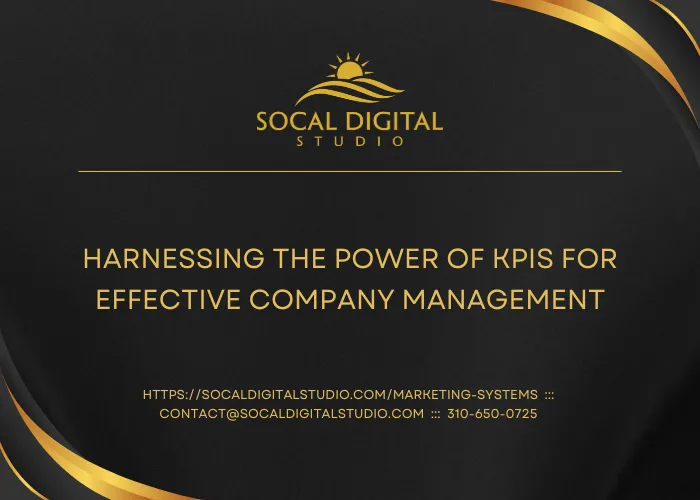PROPELLING SUCCESSFUL BUSINESSES
Actionable Best Practices

Harnessing the Power of KPIs for Effective Company Management
“The goal is to turn data into information, and information into insight” – Carly Fiorina
Introduction
In the complex and dynamic arena of business management, Key Performance Indicators (KPIs) are indispensable tools that help stakeholders gauge the health of their company. KPIs provide measurable values that reflect the effectiveness of a company in achieving key business objectives. With precise KPIs, businesses can make better decisions, streamline their operations, and enhance their strategic plans. This blog explores the critical importance of KPIs in managing a company and ensuring its sustained success.

Objective Measurement of Performance
KPIs offer objective data that assist managers in understanding whether the company is on track to achieve its goals. For instance, a business with a goal to enhance customer satisfaction might monitor the Net Promoter Score (NPS), which gauges customer loyalty and satisfaction levels based on the likelihood of customers to recommend the company to others. A rising NPS would indicate improved customer satisfaction, guiding managers to continue investing in customer service enhancements.
Focused Efforts and Resource Allocation
By highlighting areas that need improvement, KPIs help companies allocate their resources more effectively. Consider the Inventory Turnover Ratio, which measures how often a company’s inventory is sold and replaced over a period. A lower ratio than the industry average might suggest overstocking or inefficiencies, prompting businesses to adjust their inventory levels to reduce holding costs and free up capital for other initiatives.
Early Warning Signs
KPIs serve as canaries in the coal mine, providing early warnings about potential problems. Cash Conversion Cycle (CCC) is a critical KPI for cash flow management; it measures the time taken between the outlay of cash and its recovery through sales. An increasing CCC could indicate a liquidity problem, alerting management to tighten credit terms or improve collections processes.
Key KPIs Every Company Should Monitor
Financial Health KPIs
- Gross Profit Margin: Shows the percentage of revenue that exceeds the cost of goods sold (COGS). It is critical for assessing a company’s financial health and pricing strategy.
- Operating Cash Flow: Indicates the cash generated from regular operating activities, providing insight into the company’s ability to generate sufficient positive cash flow to maintain and grow its operations.
Operational Efficiency KPIs
- Employee Productivity: Measures output per employee to evaluate how effectively human resources are being utilized. For example, a tech company might track the number of software releases per developer as a KPI.
- Capacity Utilization Rate: Helps manufacturing units understand how well they are using their productive capacity. Underutilization may signal high costs and inefficiency.
Customer-Centric KPIs
- Customer Retention Rate: Essential for businesses whose success depends on recurring business, this KPI measures how well the company retains its customers over time.
- Customer Satisfaction Index: Often derived from survey data, this indicates how satisfied customers are with the company’s products or services, guiding customer service improvements.
Project Performance KPIs
- Return on Investment (ROI): For projects, ROI measures the gain or loss generated on an investment relative to the amount of money invested. It is crucial for evaluating the profitability of various initiatives.
- Project Schedule Adherence (PSA): Tracks the percentage of tasks completed on time, reflecting the project’s adherence to schedules.
Leveraging KPIs for Long-term Success
Integration with Business Strategy
KPIs should be closely aligned with the company's strategic objectives. For example, if market expansion is a goal, KPIs like Market Growth Rate and New Customer Acquisition Rate will be pivotal. These KPIs help businesses measure their success in specific markets and adjust strategies accordingly.
Regular Review and Adaptation
KPIs are not set in stone; they need regular review and adjustments to stay relevant. As market conditions and business objectives change, so too should the KPIs. A bi-annual review session can help companies stay aligned with their long-term goals and the current business environment.
Technological Enhancement
Modern software tools and platforms can automate KPI tracking and provide sophisticated analytics, making it easier for businesses to collect accurate data and perform in-depth analysis. Tools like Google Analytics for web performance, Salesforce for customer relationships, and Oracle for financial data are instrumental.
Summary
In summary, KPIs are more than just numbers on a dashboard. They are vital tools that help companies navigate through complex market landscapes, ensure operational efficiency, and achieve long-term strategic goals. By effectively selecting, monitoring, and acting on the insights these indicators provide, businesses can enhance their decision-making processes, optimize performance, and ultimately secure a competitive edge in their industries. For any business committed to success, integrating KPIs into regular management practices isn’t just an option; it’s a necessity.
Below is a categorized list of essential KPIs that businesses across industries can adapt and use according to their specific needs and goals.
Financial KPIs
1. Gross Profit Margin: (Gross Profit / Revenue) x 100 - Measures the percentage of revenue that exceeds the cost of goods sold.
2. Net Profit Margin: (Net Profit / Revenue) x 100 - Shows the percentage of revenue that remains as net profit after all expenses are deducted.
3. Operating Cash Flow: Cash generated from operations, important for assessing liquidity.
4. Return on Investment (ROI): (Net Profit / Cost of Investment) x 100 - Evaluates the profitability of an investment.
5. Current Ratio: Current Assets / Current Liabilities - Indicates the liquidity of a company by measuring its ability to cover short-term liabilities with short-term assets.
6. Debt to Equity Ratio: Total Debt / Total Equity - Compares the total debt to total equity, indicating the amount of leverage used by a company.
7. Working Capital: Current Assets - Current Liabilities - Measures a company's operational efficiency and short-term financial health.
8. Budget Variance: (Actual Spend - Budgeted Spend) / Budgeted Spend - Highlights the difference between budgeted and actual figures.
9. Cost of Goods Sold (COGS): Tracks the direct costs attributable to the production of the goods sold by a company.
10. Economic Value Added: Net Operating Profit After Taxes - (Capital x Cost of Capital) - Shows the value created in excess of the required return of the company’s shareholders.
Customer-Related KPIs
1. Customer Lifetime Value (CLV): Predicts the net profit attributed to the entire future relationship with a customer.
2. Customer Acquisition Cost (CAC): Total Marketing Costs / Number of New Customers Acquired - The cost associated with acquiring a new customer.
3. Customer Retention Rate: Measures the rate at which existing customers are retained over a given period.
4. Net Promoter Score (NPS): Assesses customer loyalty and satisfaction based on their likelihood to recommend the company.
5. Customer Satisfaction Index (CSI): Uses survey data to evaluate how satisfied customers are with the company’s products or services.
6. Customer Churn Rate: Number of Customers Lost / Initial Number of Customers x 100 - The percentage of customers who have stopped using the company's products or services during a certain time frame.
7. Customer Engagement Level: Assesses the degree of customer interaction and engagement generated by the business's initiatives.
Sales KPIs
1. Annual Recurring Revenue (ARR): The normalizing annual rate of recurring revenue from customers.
2. Monthly Recurring Revenue (MRR): Total predictable sales revenue a company expects on a monthly basis.
3. Lead Conversion Rate: (Number of New Customers / Number of Leads) x 100 - The percentage of leads that become customers.
4. Sales Growth Year-to-Date (YTD): Measures the percentage increase in sales for the current year, compared to the past year.
5. Average Purchase Value: Total Revenue / Number of Orders - Tracks the average value of each purchase made by customers.
6. Sales by Region: Tracks sales based on geographic regions, useful for understanding market penetration.
Operational KPIs
1. Capacity Utilization Rate: (Actual Output / Potential Output) x 100 - Measures the percentage of potential output that is actually being realized.
2. Employee Turnover Rate: (Number of Employees Leaving / Average Number of Employees) x 100 - Measures the rate at which employees leave the company.
3. Employee Satisfaction Index: Uses survey data to gauge the satisfaction level of employees within the organization.
4. Inventory Turnover: Cost of Goods Sold / Average Inventory - Shows how many times inventory is sold and replaced over a period.
5. Order Fulfillment Cycle Time: The average time from when a customer places an order to when they receive the product.
Marketing KPIs
1. Return on Marketing Investment (ROMI): [(Revenue Attributable to Marketing - Marketing Spending) / Marketing Spending] x 100
2. Lead to Customer Ratio: (Number of New Customers / Number of Leads) x 100 - The rate at which leads convert into customers.
3. Traffic to Lead Ratio: (Number of New Leads / Number of Visitors) x 100 - The effectiveness of your site in generating leads.
4. Social Media Engagement: Measures interactions (likes, shares, comments) on social media platforms.
5. Click-Through Rate (CTR): (Total Clicks on Ad / Total Impressions) x 100 - The percentage of people who clicked on an ad out of the total who saw it.
Project Management KPIs
1. Project Schedule Adherence (PSA): (Planned Duration - Actual Duration) / Planned Duration - Measures the adherence to project schedules.
2. Budget Adherence: Compares the budgeted or baseline cost of work performed with actual cost.
3. Return on Effort (ROE): Measures the amount of value generated per unit of effort.
4. Quality Index: An aggregate measure of quality offered by the project outputs.
These KPIs provide a robust framework to measure various aspects of a business’s performance, from financial health to customer satisfaction, operational efficiency, and beyond. By strategically selecting and meticulously monitoring the relevant KPIs, businesses can make informed decisions that drive efficiency, growth, and profitability. Each KPI should be tailored to specific business goals and needs for optimal results.
Let Us Help with Your Marketing KPIs
To desgn and manage a marketing system tailored to your business, partnering with a knowledgeable consultant and implementing a marketing system can be highly beneficial. Remember, in the world of business, effective marketing is not just money—it's customer satisfaction, retention, and your brand’s reputation on the line. Schedule a free demo with us by CLICKING HERE to discover cutting-edge ways to place your marketing resources in the most effective activities.

SUBSCRIBE TO THIS NEWSLETTER TO STAY IN THE KNOW
Please contact us with topics you would like us to cover
Dominate with Our Affordable All-in-One Marketing System
SoCal Digital Studio's Advanced All-In-One Marketing System is built to help local businesses attract, engage, convert, and retain customers with speed and consistency. It automates the communication that is essential to a business' success and continuing growth. Request a free marketing audit to uncover weaknesses and use SoCal Digital Studio's Marketing System to not only compete, but dominate the market.
All-in-One Marketing System
Leverage Powerful Marketing Tools and Sales Funnels to Nurture and Convert Customers at an Affordable Price
Our marketing system has it all and allows you to (1) capture leads via landing pages, forms, calendars, and inbound phone calls; (2) message leads via phone calls, SMS, emails, and Messenger; and (3) close leads with built-in tools for payments and analytics (including call tracking).You can also create landing pages and funnels, set up automated follow-up campaigns, schedule appointments, fine-tune marketing and sales processes, and manage all of it so nothing slips between the cracks in your dedicated marketing system.
Stellar Package
Monthly Subscription
12-Month Subscription is $4970
One-Time Set-Up Fee Varies
$297
Full System Access
5,000 Contacts
1,500 SMS or Calls
15,000 Emails
1-3 Team Members
Galactic Package
Monthly Subscription
12-Month Subscription is $6970
One-Time Set-Up Fee Varies
$497
Full System Access
7,500 Contacts
3,000 SMS or Calls
30,000 Emails
4-10 Team Members
Cosmic Package
Monthly Subscription
12-Month Subscription Is $9970
One-Time Set-Up Fee Varies
$697
Full System Access
10,000 Contacts
4,500 SMS or Calls
45,000 Emails
11-15 Team Members
